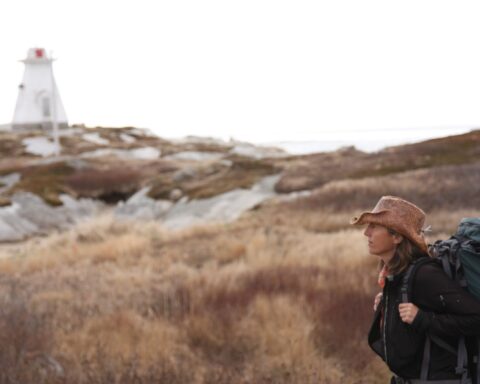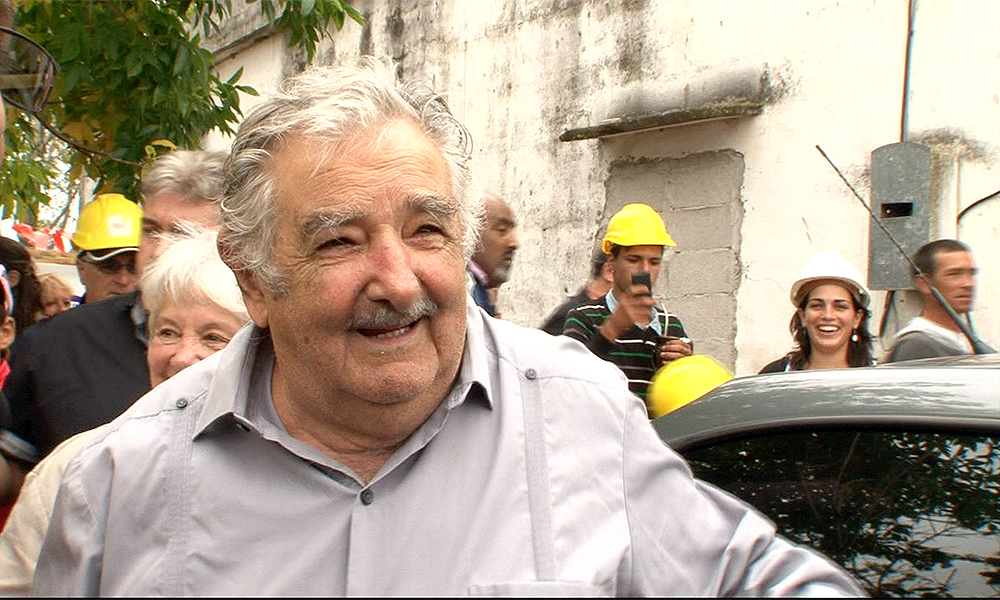“My name is Chantal Akerman. I was born in Brussels, and that’s the truth.”
—Chantel Akerman in Chantal Akerman by Chantal Akerman (1997)
In 1975, a film by an unknown young Belgian filmmaker, running over three hours in length, premiered at the Director’s Fortnight at Cannes. Starring the glamorous French film star Delphine Seyrig as a housewife performing an exacting ritual of cooking and cleaning in “real time,” Jeanne Dielman, 23 quai du Commerce, 1080 Bruxelles was unlike anything that had shown at Cannes before.
“People kept getting up and leaving. You could hear the seats banging,” the director recalled. “That’s when I realized that people couldn’t stand it.” Novelist Marguerite Duras reportedly stood up and yelled, “This woman’s crazy,” then exited the theatre. The next day, Akerman was declared an art house sensation: “Suddenly, at 25, I was informed that I was a great filmmaker.”

Watching a Chantal Akerman film is like taking a Rorschach test: what you see, or feel, depends on your own state of mind. One can analyze her work—and many have—but the director largely chose not to explain it herself. Akerman’s films require a commitment from the viewer, with long takes that provoke restlessness, or unease, unless one is willing to yield, in which case there follows acceptance or, perhaps, resignation—yes, this is how it goes, such is life. And there is beauty, always beauty, at times so breathtaking as to become heartbreaking.
Although Akerman has been celebrated for a cinema in which nothing happens, in fact, a great deal happens, on many levels, whether on the soundtrack, just beyond the frame, down hallways, or through windows partially obscured. The use of time, both prolonged and fleeting—what is lost and passing away—is central to her work. “All you have is time,” said Akerman. “In my films you are aware of every second passing by.” The result, she said, is that “you are facing yourself.”
Hailed by Le Monde as “the first masterpiece of the feminine in the history of the cinema,” volumes have been written about Jeanne Dielman and Akerman’s focus on the kitchen as both a symbol of female oppression and a kind of domestic theatre. “I don’t think a man would have made this film,” observed Akerman later. “From birth, men are taught different values. A woman washing dishes isn’t art.”

Anointed by the Village Voice as “the most important European director of her generation,” Akerman was compared to Jean Luc Godard and Rainer Werner Fassbinder for the intelligence she brought to her filmmaking. And yet, and yet…
“In spite of myself,” she lamented, “I carry the weight of history.” Her mother, Natalia, frequently cited as her muse, was a Polish Jewish Holocaust survivor whose parents died in Auschwitz. Akerman, a postwar baby, born in 1950 in Belgium, was obsessed with “survivor stories.” The trauma of her mother’s experience, although unspoken, was a kind of “suppressed violence” beneath the surface, and Akerman was deeply affected by it. In her 2013 memoir Ma mére rit (My Mother Laughs), she spoke frankly about her lifelong struggle with manic depression, which she described as “a cyclical and chronic disorder.” Tragically, she ended her own life in 2015, at the age of 65.
Long considered “a director’s director,” Akerman left behind a considerable cinematic legacy of over 40 films, crossing various genres: documentary and drama, feature length and shorts, narrative and experimental, and, later, video installations. Her work influenced countless filmmakers, including Gus Van Sant, Sofia Coppola, Kelly Reichardt, and Johanna Hogg, who were inspired to explore their own versions of filmmaking in real time.
By Akerman’s admission, “C’est grâce à, ou à cause de Godard” that she decided to become a filmmaker. A chance viewing of Pierrot le Fou at the age of 15 led her, three years later, to enroll in film school in Belgium. Bored by the classes, she dropped out to make her own first short, approaching her parents’ friends for funding, and trading diamond shares on the stock exchange.
Saute Ma Ville (Blow Up My Town) (1968) is an audacious debut, a 13-minute chamber piece exploring the dual oppression of domesticity and mental illness. In a Chaplinesque performance, Akerman portrays a young woman in frenzied perpetual motion—“washing” the floor by hurling a pail of soapy water, “polishing” her shoes, then her socks, then her legs—the mania heightened by the dissonance of Akerman’s humming on the soundtrack, rising and falling like improvised jazz. Eventually, she regards her image in a mirror (a recurring visual motif in her work), writes, “it’s all over,” lays her head on the gas stove and blows herself up. “It’s the mirror image of Jeanne Dielman,” said Akerman later.
“Instead of someone who accepts her life,” noted Akerman in an interview on the film, “here we have someone who blows all those rituals to bits … [It’s] the next generation that refuses to live the way the previous generation did.”
In the early 1970s, Akerman relocated to New York, and began attending screenings at the Anthology Film Archives, where she discovered the work of Michael Snow, Stan Brakhage, Jonas Mekas, Yvonne Rainer, and Andy Warhol. The non-narrative, minimalist form was a revelation to Akerman: “You didn’t need a story. You could still experience something emotional and palpable.”

Throughout the ’70s, Akerman created a series of her own experimental films, loosely regarded as the New York “trilogy”: Hotel Monterey (1972), La chambre (1972) and News From Home (1977). Hotel Monterey, where Akerman was staying at the time, is an hour-long, claustrophobic observation of the comings and goings of its residents. Describing her editing process, she said simply, “I was breathing, and then at one point I understood it was the time to cut. It was my breathing that decided the length of my shots.” La chambre (1972), which Akerman described as “a moving still life,” is an 11-minute visual exercise, inspired by Michael Snow’s 1969 short Back and Forth, the camera continually circling her apartment, each time discovering the filmmaker in a different pose. News from Home (1977) is a gorgeous time capsule of 1970s New York streetscapes, accompanied by readings of letters from her mother, lending the film the intimacy of a diary, with Akerman’s subtle use of rain on the soundtrack contributing to the film’s sense of longing.
Je tu il elle (I, You, He, She) (1974), Akerman’s first narrative feature, chronicles the journey of a young woman, played by the director, who leaves the isolation of her apartment to engage in sexual encounters on the road, first with an anonymous male truck driver and then with a former girlfriend.
A study in depression in the guise of a road movie, Akerman imposed her own absurdist sense of humour, including a strangely riveting sequence in which she compulsively devours sugar, by the spoonful, directly from the bag. The film culminates in an extraordinary 10-minute sexual encounter: two women, a tangle of bodies, writhing and wrestling in bed. More athletic than erotic, until the end, when it becomes explicit, the scene is at once comical and profoundly intimate. Throughout, Akerman’s camera neither turns away nor moves closer, but simply observes.

The viewer as voyeur is a common thread in her work along with the potentially alienating effect of an observational approach mitigated by the use of sound. In Je tu il elle, Akerman can be heard softly humming and breathing, imbuing the love scene with a tenderness that belies the cool eye of the camera. “There were no scenes of raw female sexuality” in films at that time, wrote Victoria Brownworth in a posthumous tribute to Akerman in the lesbian magazine Curve. The film was “new and different, feminist, and, for some, shocking.”
Buoyed by the film’s positive critical reception, Akerman returned to Paris to commit herself to narrative filmmaking but “felt like a traitor” to the experimental cause, “and when I wrote Jeanne Dielman, I thought, ‘this is total betrayal.’”
Jeanne Dielman was Akerman’s first full-length highly conceptual work, every gesture precisely choreographed. Written for Delphine Seyrig, famous for the hyper-stylized 1961 Alain Resnais film Last Year at Marienbad, the casting of the star was critical to the film. “She was quite the lady,” said Akerman. “If we saw someone making beds and doing dishes whom we normally see doing those things, we wouldn’t really see that person, so Delphine was perfect because it suddenly became visible.”
The film chronicles three days in the life of a housewife who leads “a very organized life with nothing left to chance.” By the end of the second day, she unexpectedly finds herself with an hour to spare and her highly structured life begins to unravel. Based on Akerman’s childhood memories of watching her mother and aunts perform their daily domestic routines, the director was interested in the idea of ritual as a way of staving off anxiety: “If nothing changes, nothing dangerous can happen.” Eventually, Akerman articulated the connection between Jeanne Dielman and her mother’s experiences at Auschwitz as a need to create “a smooth world. Very smooth. Without an un-ironed shirt or unpleasant surprise.”
Akerman’s coming of age as a filmmaker coincided with the second wave of feminism in the 1970s, and Jeanne Dielman became a rallying cry against the oppression of women, trapped in a prison of domesticity. “There was a great yearning to define a feminist film aesthetic,” wrote B. Ruby Rich in Film Quarterly, and Jeanne Dielman fit the bill so very perfectly.” But despite Akerman’s own feminist awareness, which included insisting on a crew composed of at least 80 per cent women for the film, she rejected any categorization: “When people say there is a feminist film language, it is like saying there is only one way for women to express themselves.”
Fuelled by a desire to pursue her own distinctive cinematic language, Akerman began working in a variety of narrative genres, including reuniting with Seyrig in Golden Eighties (1986), a playful Jacques Demy-esque musical and several visually stunning literary adaptations.
But post Jeanne Dielman, it was her documentary work that was outstanding. The stripped-down approach of the form enabled her to speak more directly to her themes, literally, in her own voice (a marvel in itself—deep, rich, and loamy, à lá Jeanne Moreau), resulting in work that was deeply personal, and at times, heartbreakingly raw.

Courtesy of Icarus Films
Un jour Pina à demandé (One Day Pina Asked…) (1983) follows choreographer Pina Bausch on the road. It’s impossible not to compare the film to Wim Wenders’ gorgeous 3D documentary Pina (2011), but Akerman’s approach is smaller, revealing as much about the director as her subject. Reading aloud from her journals, she is overcome by emotion while watching one of Pina’s performances: “It had something to do with happiness … I felt I had to defend myself from what was being expressed. Moments in the performance when I had to close my eyes. I can’t understand why.” She closes her notebook. It’s clear Akerman felt an affinity with Bausch, and the film concludes, movingly, with Bausch being asked how she see her future. She hesitates, then confesses she is afraid to ask that of herself, but wishes for “hope … strength, a lot of strength, and love,” a sentiment that could easily have been expressed by Akerman herself.
D’Est (From the East) (1993), an evocative cinematic journey through Eastern Europe after the collapse of the Soviet Union, is unquestionably Akerman’s documentary masterpiece. With no dialogue or commentary, the film is distinguished by its long tracking shots of people waiting for buses and trains, underscored by a complex aural collage. Like Jeanne Dielman, D’Est requires a willingness to yield to the film’s languid pace, which becomes magical and transformative, expressing a deep sense of poignancy and the inevitability of time passing.
“It was very important for us not to know where we were going,” said Claire Atherton, who edited many of Akerman’s films, including D’Est, in an interview in Canadian Art. “If you know too well where you want to go, you don’t feel like going anymore.” The long tracking shots of the faces of people waiting, and the images of people walking, “referred back,” observed Atherton at a screening following Akerman’s death. “To other queues, to other stories within history, but we did not talk about it.” Akerman put it more bluntly: the scenes “evoke people waiting for death.”
Two years later, Akerman collaborated with Atherton on a video installation, D’Est au bord de la fiction (From the East: Bordering on Fiction). In the accompanying text she elaborated on what she had been feeling while making the film: “Yesterday, today and tomorrow, there were, there will be, there are at this very moment, people whom history … has struck down. People who are waiting there, packed together, to be killed, beaten or starved or who walk without knowing where they are going, in groups or alone. There is nothing to do. It is obsessive and I am obsessed … Once the film is finished, I said to myself, ‘So, that’s what it was, again.’”

Akerman’s next major documentary work would be Sud (South) (1999). Although lacking the cinematic opulence of D’Est, thematically the director viewed it as a companion piece, this time turning her lens on the southern U.S. “This South,” she wrote, “where not so long ago, blacks were lynched by whites, seems to me to echo D’Est so much.” She could not shake “what continues to obsess me: History, the great and the small, the fear, the mass graves, the hatred of the other, of oneself, and also the dazzling of beauty.”
Her exploration of displacement continued with De l’autre coté (From the Other Side) (2002), about undocumented immigrants from Mexico crossing over to Arizona. Similar to Sud, she combined a mixture of landscapes and interviews shot with a small DV camera, a tool that seemed to liberate her from the need to control the aesthetic, breaking down, in effect, another wall. “My obsession with borders comes from the camps,” said Akerman in an interview with Mousse Magazine. “When you touch on that limit—and I touched it very closely through my mother, who was in the camps but never able to talk through her anxiety—this border becomes an anxious ‘Abject.’”
By now, Akerman was shooting most of her documentaries with a small DV camera, which in effect became her pen and the films her diaries. Cinematically, she began to look inward. With Là-bas (Down There) (2006), the director spent a month in Tel Aviv, isolated in her apartment, trying to make sense of the Israeli-Palestinian conflict while contemplating her Jewish identity. Filming mostly from the apartment, she trained her camera on the unremarkable daily routine of her neighbours across the street, providing a Rear Window perspective on her self-imposed exile. The use of the DV camera, combined with the focus on the windows, and the light, recalls Michael Snow’s Wavelength, and her own experimental roots. But it is her use of sound—footsteps pacing, the whistle of a kettle, a snippet of a phone conversation, and, yet again, her own distinctive voice—that transports us to another level, in which we are both observer and participant, trapped in a claustrophobic experience, with a final, glorious release at the end, by the sea. The film was awarded the Grand Prize at the Marseille International Documentary Festival and was nominated for a César.
Tragically, but perhaps, fittingly, Akerman’s cinematic journey culminated in a documentary homage to her mother, No Home Movie (2015). The film is a naked cry from the heart, visually unpolished, emotionally so raw, that it is, at times, excruciating, to watch. “Why are you filming me?” Natalia, asks. “I film everybody,” responds Chantal, behind her ever-present camera. Perpetually a seeker, Akerman is clearly in search of answers for which there are none. “The red thread of this film,” she wrote in an email to Claire Atherton, “is a character, a woman born in Poland, who arrives in Belgium in 1938 to flee the pogroms and the horror. This woman is my mother. Within and solely within her apartment in Brussels.”
Natalia Akerman passed away in 2014, before the film was released. At its premiere at the Locarno Film Festival in August 2015, there were reports of boos at the press screening. The following month, she was scheduled to present the film at the Toronto International Film Festival. But it was not to be. She had been hospitalized and, on Oct. 5, 2015, took her own life.
The title, No Home Movie, was a play on words: “Even if I have a home in Paris and sometimes in New York, whenever I was saying ‘I have to go home,’ it was going to my mother. And there is no home anymore, because she isn’t there, and when I came the last time, the home was empty,” Akerman said in Marianne Lambert’s documentary I Don’t Belong Anywhere. After her mother’s passing, Akerman had admitted she feared she no longer had anything to say. Her mother had been “the centre of my oeuvre.”
Visit OVID.tv to watch a selection of Chantal Akerman’s films, including No Home Movie, From the East, and One Day Pina Asked…














